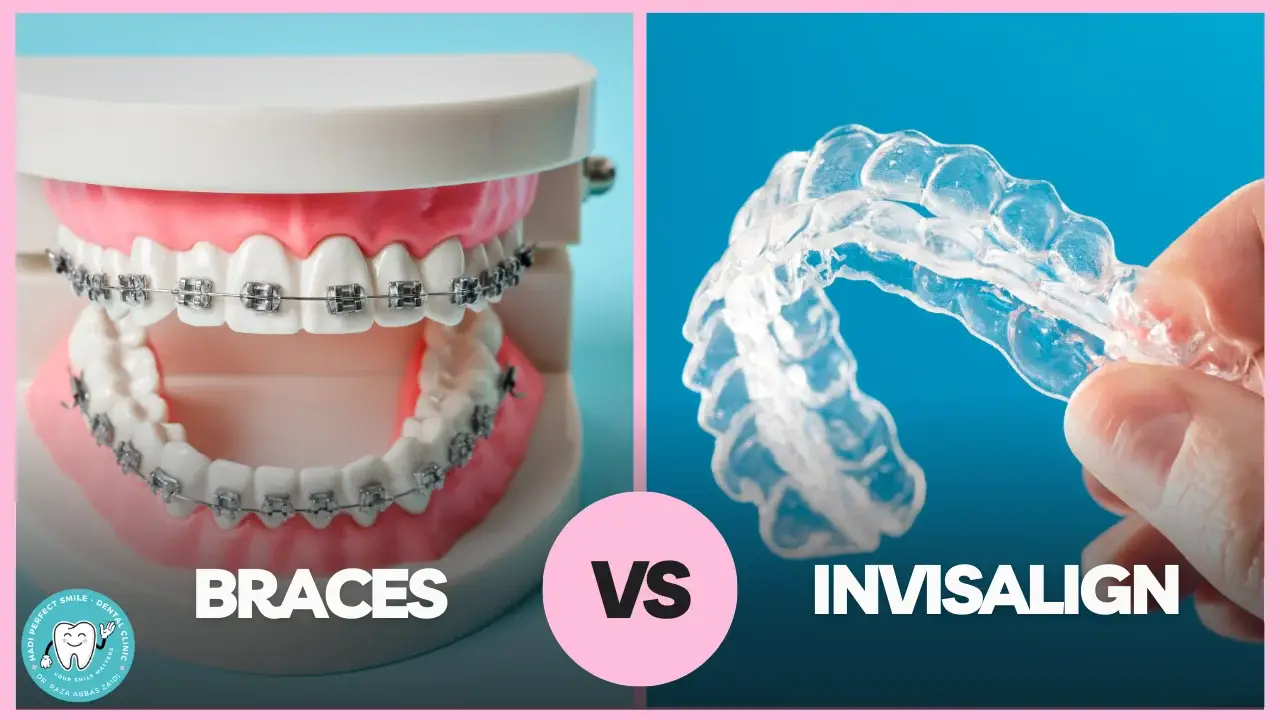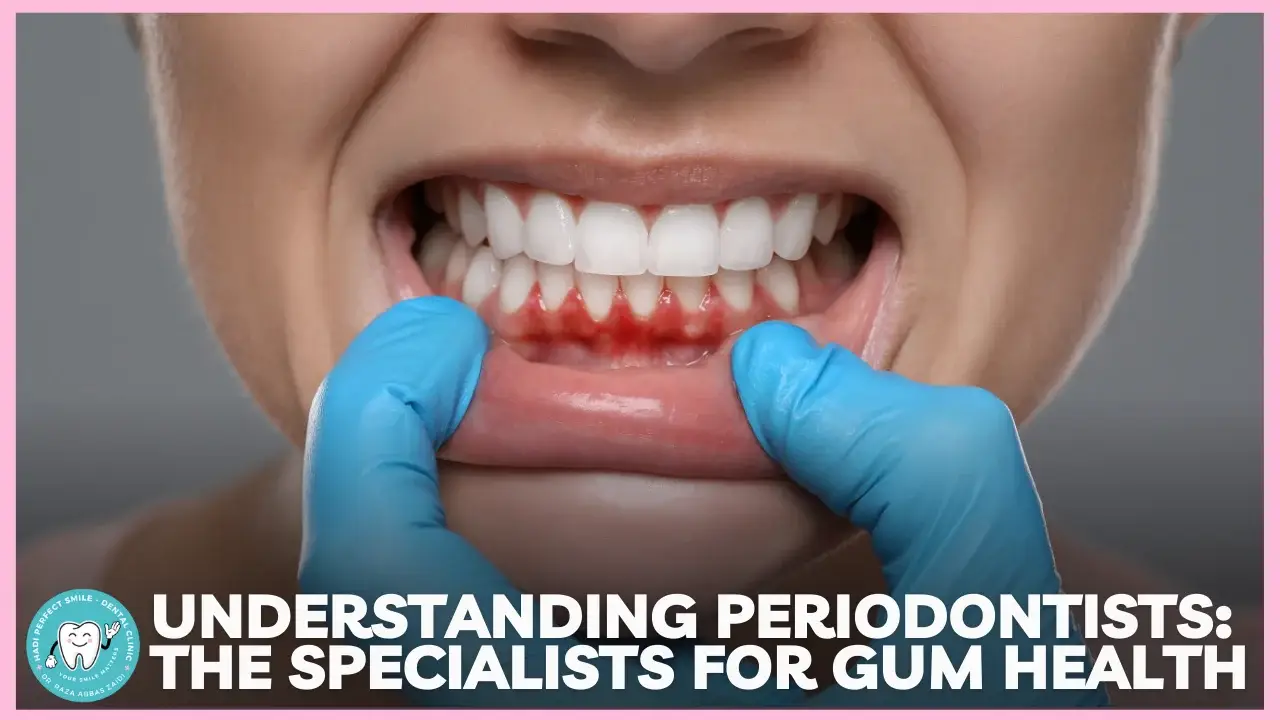At Hadi Perfect Smile Dental Clinic, we understand the importance of a confident smile. Crooked or misaligned teeth can affect your self-esteem and overall oral health. Thanks to modern orthodontic advancements, there are now two popular options for straightening teeth: traditional braces and Invisalign. But which one is the right choice for you? In this comprehensive guide, we will explore the differences between braces and Invisalign, helping you make an informed decision about your orthodontic treatment.
1. What Are Braces?
Braces are a traditional orthodontic treatment that has been used for decades to straighten teeth. They consist of metal brackets attached to each tooth and connected by wires and rubber bands. The brackets apply constant pressure to gradually move the teeth into their desired positions.

Types of Braces:
- Metal Braces: These are the most common and are made of high-quality stainless steel.
- Ceramic Braces: These are similar to metal braces but are tooth-colored, making them less noticeable.
- Lingual Braces: These are placed on the inside surface of the teeth, making them invisible from the outside.
Pros of Braces:
- Effective for treating severe orthodontic cases such as overbites, underbites, and complex tooth misalignments.
- Constant and consistent pressure ensures quick and reliable movement of teeth.
- Suitable for all ages and dental conditions.
- Can handle more complex corrections than clear aligners.
Cons of Braces:
- More noticeable than Invisalign, especially metal braces.
- Can be uncomfortable due to the metal components, causing irritation to the mouth.
- Braces make it harder to clean teeth properly, leading to potential oral hygiene issues.
- Certain foods must be avoided (sticky, chewy, or hard foods).
2. What Is Invisalign?
Invisalign is a modern, nearly invisible orthodontic treatment that uses a series of clear plastic aligners to gradually move the teeth into the desired position. The aligners are custom-made and replaced every one to two weeks as the teeth shift.

How Invisalign Works:
- The process starts with a 3D scan of your teeth, which is used to create a series of clear aligners.
- Each aligner is worn for about 20-22 hours per day, and it gradually moves the teeth.
- The aligners are removable, making it easier to eat and maintain oral hygiene.
Pros of Invisalign:
- Aesthetic appeal: Invisalign is nearly invisible, making it a great option for those who prefer a discreet look.
- Comfort: Since the aligners are made of smooth plastic, they are more comfortable than metal braces.
- Removable: You can remove the aligners when eating or brushing, allowing for better oral hygiene.
- Fewer dietary restrictions: Since the aligners can be removed, you can eat whatever you like without worrying about damaging the braces.
Cons of Invisalign:
- Not suitable for severe orthodontic cases.
- Requires discipline to wear the aligners for 20-22 hours a day; non-compliance can extend treatment time.
- Aligners need to be replaced regularly, which can be inconvenient for some patients.
- Generally more expensive than traditional braces.
3. Braces vs. Invisalign: A Side-by-Side Comparison
| Factor | Braces | Invisalign |
|---|---|---|
| Appearance | Metal braces are visible; ceramic braces are less so. | Nearly invisible due to clear plastic aligners. |
| Comfort | Can cause discomfort due to metal brackets and wires. | More comfortable with smooth plastic aligners. |
| Removability | Fixed, non-removable. | Removable for eating, drinking, and cleaning. |
| Oral Hygiene | More difficult to clean teeth and gums around braces. | Easy to remove aligners for proper brushing and flossing. |
| Diet Restrictions | Certain foods must be avoided. | No dietary restrictions; aligners are removed to eat. |
| Treatment Time | Usually takes 1-3 years, depending on the case. | Similar treatment time, but discipline is crucial. |
| Effectiveness | Ideal for severe misalignments and bite issues. | Best for mild to moderate cases. |
| Cost | Typically more affordable than Invisalign. | Usually more expensive than braces. |
4. Who Should Choose Braces?
Braces are a great option for:
- Severe orthodontic issues: If you have significant misalignment, overbites, underbites, or crowding, braces may be the better choice.
- Younger patients: Braces are often recommended for teenagers and children who may not adhere to wearing aligners as consistently as needed.
- Patients who want guaranteed results: Since braces are fixed and provide constant pressure, they are ideal for cases where quick and consistent movement of the teeth is necessary.
5. Who Should Choose Invisalign?
Invisalign is ideal for:
- Adults and older teens who prefer a more discreet look during their orthodontic treatment.
- Mild to moderate misalignments such as slight crowding or spacing issues.
- Patients who are committed to wearing the aligners for the required 20-22 hours per day.
- Individuals who prefer the convenience of removing aligners when eating or brushing.
6. Cost Comparison: Braces vs. Invisalign
Braces:
- The cost of braces can vary based on the type (metal, ceramic, or lingual), but they generally range from ₹25,000 to ₹80,000.
- Braces typically come with fewer follow-up appointments compared to Invisalign since adjustments are made less frequently.
Invisalign:
- Invisalign treatment usually costs between ₹60,000 and ₹1,80,000.
- Additional costs may arise if patients lose or damage their aligners, as replacements are required.
At Hadi Perfect Smile Dental Clinic, we offer flexible payment plans and will help you navigate the financial aspect of your orthodontic treatment to make it as affordable as possible.
7. Maintenance and Aftercare
Braces:
- Regular cleaning and flossing are essential to avoid plaque buildup around the brackets and wires.
- Patients need to attend follow-up appointments every 4-6 weeks for adjustments.
Invisalign:
- Aligners must be cleaned daily to prevent discoloration and bacterial buildup.
- Patients receive new aligners every 1-2 weeks and must attend check-ups every 6-8 weeks to monitor progress.
After your treatment with either braces or Invisalign, wearing a retainer is necessary to maintain the results and prevent your teeth from shifting back to their original position.
8. Final Verdict: Braces or Invisalign?
Choosing between braces and Invisalign depends on your specific dental needs, lifestyle, and preferences.
- If you have severe misalignments or complex bite issues, braces may be the more effective option.
- If you value discretion, comfort, and removability, Invisalign could be the ideal choice for you.
At Hadi Perfect Smile Dental Clinic, our experienced dental team will help you decide which treatment is best suited to your needs after a comprehensive consultation.
Conclusion: Both braces and Invisalign are excellent orthodontic options that can give you the smile you’ve always wanted. Whether you choose the reliability of traditional braces or the subtlety of Invisalign, Hadi Perfect Smile Dental Clinic is here to guide you through the process. Schedule a consultation today and take the first step toward a straighter, more confident smile.
Ready to transform your smile? Contact Hadi Perfect Smile Dental Clinic to book your consultation and explore the best orthodontic treatment for you. Let us help you achieve the perfect smile with braces or Invisalign!
FAQs:
Q: Can Invisalign treat all orthodontic issues? A: Invisalign is ideal for mild to moderate issues, but severe misalignments may require braces.
Q: How long do I have to wear braces or Invisalign? A: Treatment time for both braces and Invisalign typically ranges from 12-36 months, depending on the complexity of your case.
Q: Are braces more effective than Invisalign? A: Both treatments are effective, but braces are generally better for complex cases.
Q: Can I switch from braces to Invisalign during treatment? A: It may be possible to switch, but it depends on your specific case and the progress of your treatment.






